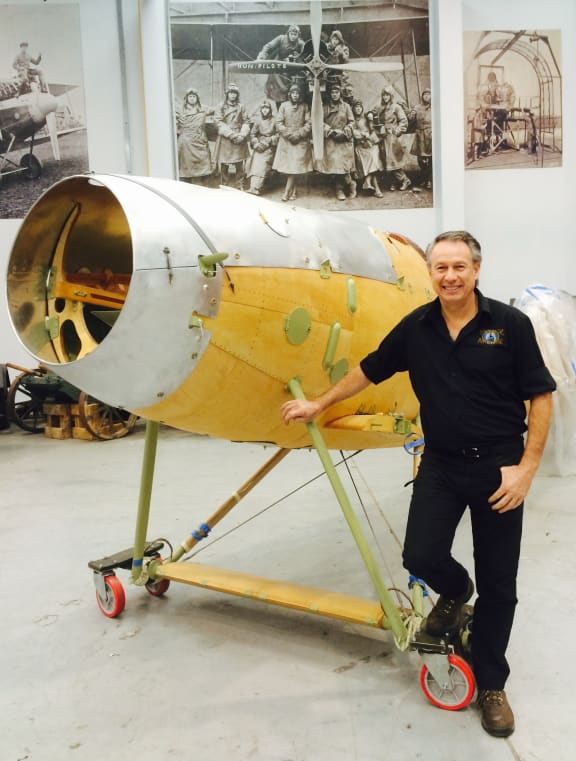by Ruth Beran
In the Wellington suburb of Kilbirnie is a factory, making reproduction World War I airplanes.
“It’s a very, very time consuming process, and our aircraft are really just later model airplanes. They’re just like you’d find coming off the assembly line 100 years ago,” says Production Manager Gene DeMarco from the Vintage Aviator.
Built for museums or collectors, the airplanes duplicate the original. “So any flaws, or characteristics that the original airplane had, our airplanes have as well,” says Gene.

Gene DeMarco with a partly reconstructed Albatros DVa airplane Photo: RNZ / Ruth Beran
While there are quality management systems in place at the Vintage Aviator, the same sort of requirements that Cessna, Piper, Beechcraft or Boeing would have, the techniques used to make the planes can date back a century.
For example, the wings are made from wood, and covered with Irish linen.
“So the linen fabric goes over the whole structure, and gets sewed around the edges essentially forming a bag over all that nice woodwork,” says Gene. This loosely fit bag is sewed round the edges and sealed and then sprayed with water. “Like most natural fabrics, you spray water on it, they shrink,” says Gene. After the fabric has shrunk it is coated with butyl cellulose acetate, also known as butyrate dope. This shrinks the fabric ever more, and then a process called rib stitching is used. “That keeps the fabric clinging to this aerofoil shape that the wing has,” says Gene. The rib stitching means that if the wing gets a puncture or tear, it will only affect one section of the wing.
Metal parts are also made at the Vintage Aviator, including the engines. “So whenever we build one of these engines, there’s a lot of other components that have to go into it, so it’s not just six cylinders and a crank case and crank shaft, there’s all these other parts that have numerous components that have to be made,” says Gene.
Every part also has to be tested. Non-ferrous parts are tested for cracks or imperfections using a dye penetrant to check for cracks or imperfections. Anything ferrous, like steel, is tested using magnetic particle inspection. “Because we’re a low volume manufacturer we have the ability to inspect every single part we make, whether it’s welded, cast, or forged,” says Gene.
The airplanes are true to original except for some substitutions for safety and each is test flown in Masterton for anywhere between 2 – 10 hours.
The whole process of building a plane takes years, beginning with information gathering and then design. For example, a plane like the Albatros DVa, was recreated from only two existing examples. A FaroArm, or coordinate measuring machine, was used to optically scan one of those examples at the Australian War Memorial in Canberra.
Then a digital drawing set is created so that parts can be approved. “So from the project inception (once we decide on an airplane) to building the first part, can be up to two years. And it can take us another year before we build that first airplane. So it might be three years for the first airplane and then sort of each subsequent airplane a year after that, takes about a year to build each one, give or take. It depends on the complexity of the plane,” says Gene.
A Vintage Aviator plane can cost between $500,000 to $2 million, and typically three or four planes are built for each type of aircraft. “We tend to keep one or two for our own collection, and then it allows us to trade one or sell one to collectors,” says Gene.
Each aircraft has its own personality and Gene says it’s fantastic to have so many authentic World War I planes here in New Zealand.
“When you see one of these created from literally raw materials, wire, sticks and a couple of pieces of steel, that sort of thing, and then it’s an airplane ready for flight, it’s truly an amazing process,” he says. “Seeing one ready to fly and take to the sky again it’s sort of like recreating that little bit of history.”
You can listen to an extended version of the tour of the Vintage Aviator here:
You can listen to the on-air version of the Vintage Aviator story below:

